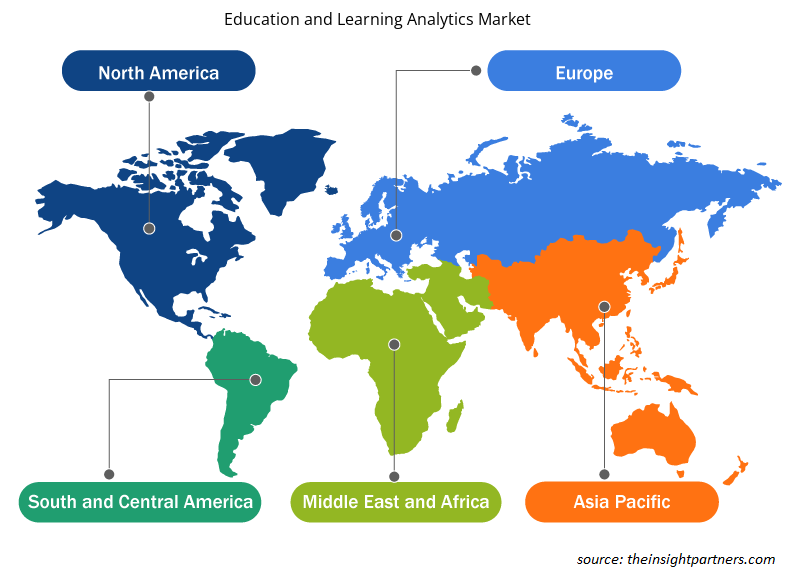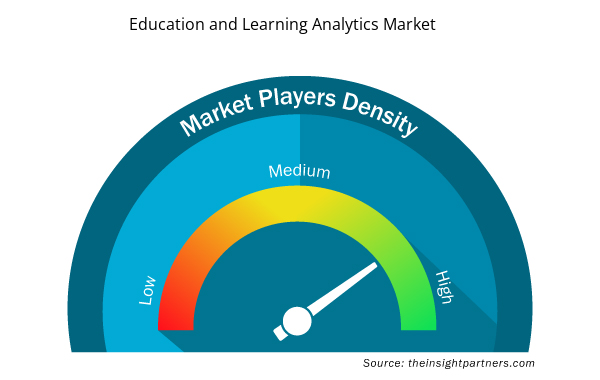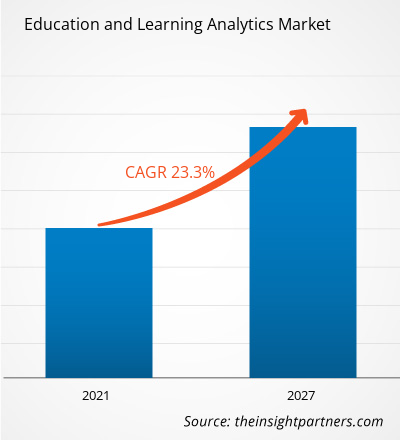[Forschungsbericht] Der Markt für Bildungs- und Lernanalysen soll von 3.890,3 Millionen US-Dollar im Jahr 2020 auf 16.835,9 Millionen US-Dollar im Jahr 2027 wachsen; von 2020 bis 2027 wird mit einer durchschnittlichen jährlichen Wachstumsrate von 23,3 % gerechnet.
Die steigende Nachfrage nach Online-Kursen und professionellen Zertifizierungen trägt zum Wachstum des Marktes bei. Die steigende Nachfrage nach Online-Kursen und ein dramatischer Anstieg der Zahl der Anmeldungen für Online-Programme schaffen eine riesige Chance für Anbieter, die auf dem Markt für Bildungs- und Lernanalysen tätig sind . Der Markt für Online-Kurse ist aufgrund der Präsenz einer großen Anzahl von Akteuren, die weltweit auf dem Markt tätig sind, stark fragmentiert. Die Anbieter von Lernanalysen müssen sich auf Partnerschaften mit Online-Kursanbietern konzentrieren, um ihre Präsenz weltweit auszubauen.
Online-Lernen wird zu einem wesentlichen Bestandteil der Bildungslandschaft. Die Einschreibungen in Online-Programme werden zunehmend durch die steigende Zahl von Studenten vorangetrieben, die nach flexiblen Formaten für Zertifikate, Kurse und Studiengänge suchen, um ihre berufliche Karriere zu unterstützen und weiterführende Studien zu verfolgen. Studenten, die sich für Programme auf dem Campus eingeschrieben haben, konzentrieren sich während ihrer Einschreibung auch darauf, sich für Hybrid- oder Online-Kurse anzumelden. Online-Masterstudiengänge boomen unter Studenten, da viele renommierte und große Institutionen aufgrund der hochwertigen technischen Unterstützung beim Lernerlebnis auf verschiedene Online-Studiengänge umsteigen. Darüber hinaus konzentrieren sich auch Unternehmensfachleute darauf, verschiedene Kurse für ihr berufliches Wachstum zu belegen. Daher wird erwartet, dass die steigende Nachfrage nach Online-Kursen eine enorme Chance für Anbieter von Bildungs- und Lernanalysen weltweit bietet.
Passen Sie diesen Bericht Ihren Anforderungen an
Sie erhalten kostenlos individuelle Anpassungen an jedem Bericht, einschließlich Teilen dieses Berichts oder einer Analyse auf Länderebene, eines Excel-Datenpakets sowie tolle Angebote und Rabatte für Start-ups und Universitäten.
- Holen Sie sich die wichtigsten Markttrends aus diesem Bericht.Dieses KOSTENLOSE Beispiel umfasst eine Datenanalyse von Markttrends bis hin zu Schätzungen und Prognosen.
Auswirkungen der COVID-19-Pandemie auf den Markt für Bildungs- und Lernanalysen
Obwohl es unterschiedliche Ansichten über die Schäden gibt, die COVID-19 verursachen kann, bleibt die Tatsache bestehen, dass sich COVID-19 weltweit ausbreitet. Neue Fälle nehmen unter anderem in den USA, Kanada, Europa, Afrika, dem Nahen Osten, Indien, Australien, Südkorea, Indien und Japan sowie in mehreren anderen Ländern zu. Obwohl die Auswirkungen auf verschiedene Unternehmen bekannt sind, ist auch der Bildungssektor mit den größten Störungen seit Menschengedenken konfrontiert.
Bildungseinrichtungen weltweit reagieren auf Reiseverbote und Quarantänen mit der Umstellung auf Online-Lernen. Der Notstand könnte einen Online-Boom im Bildungsbereich auslösen – oder zumindest die Länder besser auf den nächsten Notstand vorbereiten.
Markteinblicke – Markt für Bildungs- und Lernanalysen
Zunehmende Einführung fortschrittlicher Technologien in Bildungseinrichtungen in Entwicklungsländern
Bildungseinrichtungen investieren massiv in fortschrittliche Technologien, um sich einen Wettbewerbsvorteil zu verschaffen und das bestmögliche Bildungssystem einzuführen. Andererseits sind auch die Studenten bereit, zu investieren, um die beste Ausbildung zu erhalten. Sowohl Bildungseinrichtungen als auch Studenten haben ein hohes Potenzial, in das technologiegetriebene Bildungssystem zu investieren, das einen großen Einfluss auf das Marktwachstum hat. Schulen und Universitäten investieren in Technologien, um ihre Bildungsabläufe zu verbessern, beispielsweise in die Finanzplanung, Kursplanung, Studentenbindung und den effektiven Prozess der Informationsübermittlung an Studenten.
Der Bildungssektor hat mit so unterschiedlichen technologischen Fortschritten experimentiert, von Unterrichtsprogrammen bis hin zu app-basiertem Lernen. Einige dieser Technologien sind zu einem festen Bestandteil des Hochschulsystems geworden. Die sich rasch entwickelnde Technologie verändert den Bildungssektor.
Fortschrittliche Technologien wie Big-Data-Analysen bieten Pädagogen beispiellose Möglichkeiten, ihre Schüler auf neue Weise zu erreichen. Sie ermöglichen ein tieferes Verständnis der Lernerfahrungen der Schüler und helfen auch, den Zustand des Bildungssystems zu bewerten. Einige der wichtigsten Bereiche, in denen Big Data im Bildungssektor eine Schlüsselrolle spielt, sind maßgeschneiderte Programme, die Verbesserung der Schülerergebnisse, die Reduzierung der Abbruchquote und andere. In ähnlicher Weise ermöglicht Lernanalysen die Verbesserung des Kursbereitstellungsprozesses, des Leistungsmanagements, des Betriebsmanagements, des Finanzmanagements und anderer Bereiche. All diese mit den Technologien verbundenen Vorteile ermöglichen es den Bildungseinrichtungen, intelligente Technologielösungen zu übernehmen. Die zunehmende Einführung fortschrittlicher Technologielösungen im Bildungssektor wird voraussichtlich den globalen Markt für Bildungs- und Lernanalysen im Prognosezeitraum ankurbeln.
Komponentenbasierte Erkenntnisse
Basierend auf den Komponenten ist der Markt für Bildungs- und Lernanalysen in Software und Dienstleistungen unterteilt. Das Softwaresegment hatte 2019 den größten Marktanteil.
Die Akteure auf dem Markt für Bildungs- und Lernanalysen konzentrieren sich hauptsächlich auf die Entwicklung fortschrittlicher und effizienter Produkte.
- Im Jahr 2019 investierte SAS Institute Inc. in die Menschen hinter der Analytik, um die neue Generation darin zu schulen, das Mögliche zu verändern und eine Belegschaft für eine veränderte Wirtschaft auszubilden. Während des SAS® Global Forum 2019 wurden mehrere neue Programme und Initiativen vorgestellt – alle Teil des allgemeinen Engagements von SAS, die Analytikausbildung für alle zu fördern.
- Im Jahr 2019 erwarb Microsoft DataSense, ein Integration Platform-as-a-Service-Produkt (IPaaS) für Anbieter von Bildungslösungen und US-Schulbezirke, von der Firma BrightBytes aus San Francisco. Das Entwicklungsteam wird im Rahmen der Transaktion der globalen Bildungsabteilung von Microsoft beitreten.
Der Markt für Bildungs- und Lernanalysen ist wie folgt segmentiert:
Regionale Einblicke in den Markt für Bildungs- und Lernanalysen
Die regionalen Trends und Faktoren, die den Markt für Bildungs- und Lernanalysen im Prognosezeitraum beeinflussen, wurden von den Analysten von Insight Partners ausführlich erläutert. In diesem Abschnitt werden auch die Marktsegmente und die Geografie für Bildungs- und Lernanalysen in Nordamerika, Europa, im asiatisch-pazifischen Raum, im Nahen Osten und Afrika sowie in Süd- und Mittelamerika erörtert.

- Erhalten Sie regionale Daten zum Markt für Bildungs- und Lernanalysen
Umfang des Marktberichts zu Bildungs- und Lernanalysen
| Berichtsattribut | Details |
|---|---|
| Marktgröße im Jahr 2020 | 3,89 Milliarden US-Dollar |
| Marktgröße bis 2027 | 16,84 Milliarden US-Dollar |
| Globale CAGR (2020 - 2027) | 23,3 % |
| Historische Daten | 2018-2019 |
| Prognosezeitraum | 2021-2027 |
| Abgedeckte Segmente | Nach Komponente
|
| Abgedeckte Regionen und Länder | Nordamerika
|
| Marktführer und wichtige Unternehmensprofile |
|
Dichte der Marktteilnehmer im Bereich Bildungs- und Lernanalyse: Die Auswirkungen auf die Geschäftsdynamik verstehen
Der Markt für Bildungs- und Lernanalysen wächst rasant. Dies wird durch die steigende Nachfrage der Endnutzer aufgrund von Faktoren wie sich entwickelnden Verbraucherpräferenzen, technologischen Fortschritten und einem größeren Bewusstsein für die Vorteile des Produkts vorangetrieben. Mit der steigenden Nachfrage erweitern Unternehmen ihr Angebot, entwickeln Innovationen, um die Bedürfnisse der Verbraucher zu erfüllen, und nutzen neue Trends, was das Marktwachstum weiter ankurbelt.
Die Marktteilnehmerdichte bezieht sich auf die Verteilung der Firmen oder Unternehmen, die in einem bestimmten Markt oder einer bestimmten Branche tätig sind. Sie gibt an, wie viele Wettbewerber (Marktteilnehmer) in einem bestimmten Marktraum im Verhältnis zu seiner Größe oder seinem gesamten Marktwert präsent sind.
Die wichtigsten Unternehmen auf dem Markt für Bildungs- und Lernanalysen sind:
- Wasserscheidesysteme, Inc.
- SAS Institute Inc.
- SAP SE
- Microsoft Corporation
- Die glücklichsten Köpfe
Haftungsausschluss : Die oben aufgeführten Unternehmen sind nicht in einer bestimmten Reihenfolge aufgeführt.

- Überblick über die wichtigsten Akteure auf dem Markt für Bildungs- und Lernanalysen
Markt für Bildungs- und Lernanalysen – nach Komponenten
- Software
- Dienstleistungen
Markt für Bildungs- und Lernanalysen – nach Anwendung
- Leistungsmanagement
- Betriebsführung
- Budget- und Finanzmanagement
- Mitarbeitergewinnung und -bindung
- Curriculumentwicklung und Interventionsmanagement
Markt für Bildungs- und Lernanalysen – nach Endbenutzer
- Akademiker
- Unternehmen
Markt für Bildungs- und Lernanalysen – nach Geografie
Nordamerika
- UNS
- Kanada
- Mexiko
Europa
- Frankreich
- Deutschland
- Italien
- Russland
- Vereinigtes Königreich
- Restliches Europa
Asien-Pazifik (APAC)
- Japan
- China
- Australien
- Indien
- Südkorea
- Restlicher Asien-Pazifik-Raum
Naher Osten und Afrika (MEA)
- Saudi-Arabien
- Vereinigte Arabische Emirate
- Südafrika
- Rest von MEA
Südamerika (SAM)
- Brasilien
- Argentinien
- Rest von SAM
Markt für Bildungs- und Lernanalysen – Firmenprofile
- Wasserscheidesysteme, Inc.
- SAS Institute Inc.
- SAP SE
- Microsoft Corporation
- Die glücklichsten Köpfe
- Ellucian Company LP
- Blackboard Inc.
- Alteryx Inc.
- InetSoft Technology Corp.
- Saba Software, Inc.
- Historische Analyse (2 Jahre), Basisjahr, Prognose (7 Jahre) mit CAGR
- PEST- und SWOT-Analyse
- Marktgröße Wert/Volumen – Global, Regional, Land
- Branche und Wettbewerbsumfeld
- Excel-Datensatz



Report Coverage
Revenue forecast, Company Analysis, Industry landscape, Growth factors, and Trends

Segment Covered
This text is related
to segments covered.

Regional Scope
North America, Europe, Asia Pacific, Middle East & Africa, South & Central America

Country Scope
This text is related
to country scope.
Häufig gestellte Fragen
The education and learning analytics market was dominated by North America due to developed economies such as the US, Canada, and Mexico. The US and Canada are among the most advanced countries in the region, in terms of technology adoption in almost every sector, including education and training. Moreover, the presence of major education and learning analytics players, along with the widespread awareness regarding these solutions, is anticipated to further propel the market growth during the forecast period.
Increasing demand for quality assurance and quality improvement in education system is driving the demand for learning analytics. Many educational institutes are focusing on quality assurance and quality improvement in the education system to fulfill the demand from end-users. Teaching staffs are using various data to improve teaching practices. Most of the colleges and universities are using learning analytics tool as a diagnostic tool on an individual and systematic level. At the individual level, the learning analytics are used for identifying issues, and at a systematic level, it is used for the design of modules and degree programs.
Software segment by component in the education and learning analytics market led the market in 2019. Along with increasing digitalization, businesses of all sizes are focusing on adopting automated solutions to ease their business process. The advancements in applications of Information, Communication, and Technology (ICT) are paving the way for effective businesses. Education and learning analytics software helps to improve the quality of education is increasing with the growing volume of student’s data generated from different systems, such as Virtual Learning Environment (VLE), Learning Management System (LMS), student information system, or a variety of library systems. The software segment exceeds the services segment and is expected to witness the maturation in the future due to the higher adoption of education and learning analytics software solutions.
Trends and growth analysis reports related to Technology, Media and Telecommunications : READ MORE..
The List of Companies - Global Education and Learning Analytics Market
- Watershed Systems, Inc.
- SAS Institute Inc.
- SAP SE
- Microsoft Corporation
- Happiest Minds
- Ellucian Company L.P.
- Blackboard Inc.
- Alteryx Inc.
- InetSoft Technology Corp.
- Saba Software, Inc.
The Insight Partners performs research in 4 major stages: Data Collection & Secondary Research, Primary Research, Data Analysis and Data Triangulation & Final Review.
- Data Collection and Secondary Research:
As a market research and consulting firm operating from a decade, we have published and advised several client across the globe. First step for any study will start with an assessment of currently available data and insights from existing reports. Further, historical and current market information is collected from Investor Presentations, Annual Reports, SEC Filings, etc., and other information related to company’s performance and market positioning are gathered from Paid Databases (Factiva, Hoovers, and Reuters) and various other publications available in public domain.
Several associations trade associates, technical forums, institutes, societies and organization are accessed to gain technical as well as market related insights through their publications such as research papers, blogs and press releases related to the studies are referred to get cues about the market. Further, white papers, journals, magazines, and other news articles published in last 3 years are scrutinized and analyzed to understand the current market trends.
- Primary Research:
The primarily interview analysis comprise of data obtained from industry participants interview and answers to survey questions gathered by in-house primary team.
For primary research, interviews are conducted with industry experts/CEOs/Marketing Managers/VPs/Subject Matter Experts from both demand and supply side to get a 360-degree view of the market. The primary team conducts several interviews based on the complexity of the markets to understand the various market trends and dynamics which makes research more credible and precise.
A typical research interview fulfils the following functions:
- Provides first-hand information on the market size, market trends, growth trends, competitive landscape, and outlook
- Validates and strengthens in-house secondary research findings
- Develops the analysis team’s expertise and market understanding
Primary research involves email interactions and telephone interviews for each market, category, segment, and sub-segment across geographies. The participants who typically take part in such a process include, but are not limited to:
- Industry participants: VPs, business development managers, market intelligence managers and national sales managers
- Outside experts: Valuation experts, research analysts and key opinion leaders specializing in the electronics and semiconductor industry.
Below is the breakup of our primary respondents by company, designation, and region:

Once we receive the confirmation from primary research sources or primary respondents, we finalize the base year market estimation and forecast the data as per the macroeconomic and microeconomic factors assessed during data collection.
- Data Analysis:
Once data is validated through both secondary as well as primary respondents, we finalize the market estimations by hypothesis formulation and factor analysis at regional and country level.
- Macro-Economic Factor Analysis:
We analyse macroeconomic indicators such the gross domestic product (GDP), increase in the demand for goods and services across industries, technological advancement, regional economic growth, governmental policies, the influence of COVID-19, PEST analysis, and other aspects. This analysis aids in setting benchmarks for various nations/regions and approximating market splits. Additionally, the general trend of the aforementioned components aid in determining the market's development possibilities.
- Country Level Data:
Various factors that are especially aligned to the country are taken into account to determine the market size for a certain area and country, including the presence of vendors, such as headquarters and offices, the country's GDP, demand patterns, and industry growth. To comprehend the market dynamics for the nation, a number of growth variables, inhibitors, application areas, and current market trends are researched. The aforementioned elements aid in determining the country's overall market's growth potential.
- Company Profile:
The “Table of Contents” is formulated by listing and analyzing more than 25 - 30 companies operating in the market ecosystem across geographies. However, we profile only 10 companies as a standard practice in our syndicate reports. These 10 companies comprise leading, emerging, and regional players. Nonetheless, our analysis is not restricted to the 10 listed companies, we also analyze other companies present in the market to develop a holistic view and understand the prevailing trends. The “Company Profiles” section in the report covers key facts, business description, products & services, financial information, SWOT analysis, and key developments. The financial information presented is extracted from the annual reports and official documents of the publicly listed companies. Upon collecting the information for the sections of respective companies, we verify them via various primary sources and then compile the data in respective company profiles. The company level information helps us in deriving the base number as well as in forecasting the market size.
- Developing Base Number:
Aggregation of sales statistics (2020-2022) and macro-economic factor, and other secondary and primary research insights are utilized to arrive at base number and related market shares for 2022. The data gaps are identified in this step and relevant market data is analyzed, collected from paid primary interviews or databases. On finalizing the base year market size, forecasts are developed on the basis of macro-economic, industry and market growth factors and company level analysis.
- Data Triangulation and Final Review:
The market findings and base year market size calculations are validated from supply as well as demand side. Demand side validations are based on macro-economic factor analysis and benchmarks for respective regions and countries. In case of supply side validations, revenues of major companies are estimated (in case not available) based on industry benchmark, approximate number of employees, product portfolio, and primary interviews revenues are gathered. Further revenue from target product/service segment is assessed to avoid overshooting of market statistics. In case of heavy deviations between supply and demand side values, all thes steps are repeated to achieve synchronization.
We follow an iterative model, wherein we share our research findings with Subject Matter Experts (SME’s) and Key Opinion Leaders (KOLs) until consensus view of the market is not formulated – this model negates any drastic deviation in the opinions of experts. Only validated and universally acceptable research findings are quoted in our reports.
We have important check points that we use to validate our research findings – which we call – data triangulation, where we validate the information, we generate from secondary sources with primary interviews and then we re-validate with our internal data bases and Subject matter experts. This comprehensive model enables us to deliver high quality, reliable data in shortest possible time.


 Holen Sie sich ein kostenloses Muster für diesen Bericht
Holen Sie sich ein kostenloses Muster für diesen Bericht